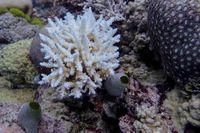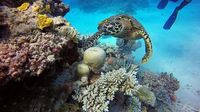The Great Barrier Reef, a shimmering jewel off Australia's northeast coast and a UNESCO World Heritage Site, is facing its greatest crisis in decades. On August 7, 2025, the Australian Institute of Marine Science (AIMS) released its annual survey, revealing that the Reef has suffered its largest annual loss of live coral in 39 years. The culprit? Bleaching, driven primarily by climate change, which has battered the world’s largest coral ecosystem and sent shockwaves through both the scientific and conservation communities.
Despite this staggering loss, AIMS noted a peculiar twist: thanks to a period of increasing coral cover since 2017, the overall area of living coral remains close to its long-term average. Yet, this silver lining is thin. The report underscores a new era of volatility for the Reef, as climate-driven disturbances become more frequent and severe. "These are substantial impacts and evidence that the increasing frequency of coral bleaching is really starting to have detrimental effects on the Great Barrier Reef," Mike Emslie, who heads AIMS’ long-term monitoring program, told the Associated Press.
The numbers are sobering. The Great Barrier Reef stretches some 1,500 kilometers (900 miles) along Queensland’s coast, covering an astonishing 344,000 square kilometers (133,000 square miles). In 2024 alone, live coral cover shrank by nearly a third in the southern region, a quarter in the north, and by 14% in the central region. While live coral cover had reached the highest levels in 39 years prior to this event, the losses from such a high starting point only partially cushioned the blow, according to AIMS.
This devastation is part of a much larger, global problem. The ongoing coral bleaching event, which began in January 2023 and was declared a global crisis in April 2024, is the fourth and largest on record. Nearly 84% of the world’s coral reefs have been affected, according to the U.S. National Oceanic and Atmospheric Administration’s coral reef watch. At least 83 countries have seen their reefs suffer under the relentless heat. The previous biggest event, from 2014 to 2017, affected 68.2% of reefs—a figure now easily eclipsed.
Australia has not been spared. In March 2025, aerial surveys of 281 reefs across the Torres Strait and the northern Great Barrier Reef revealed widespread bleaching. Of those reefs, 78 were more than 30% bleached, a clear sign of the severity and reach of this crisis. Coral, as scientists explain, can survive short bursts of hot water, but prolonged exposure is deadly. When temperatures stay high for weeks, corals expel the algae living in their tissues—algae that provide both their vibrant colors and much of their energy. The result is bleaching: the coral turns white, becoming weaker and more susceptible to disease. While bleached corals aren’t necessarily dead, their odds of recovery dwindle as stressors mount.
The Intergovernmental Panel on Climate Change (IPCC) sounded the alarm as far back as 2018, warning that coral reefs are a "unique and threatened system" especially vulnerable to warming beyond 1.5°C above pre-industrial levels. The world has already warmed 1.3°C. The IPCC cautioned that at just 1.2°C of warming, many coral-dominated ecosystems could become "non-existent," with coral abundance near zero in many locations. Back-to-back bleaching events in the mid-2010s hinted that scientists may have underestimated the risks climate change poses to coral reefs.
These scientific findings have not gone unnoticed by conservationists, who are now raising their voices louder than ever. On August 10, 2025, conservation groups sharply criticized the Queensland government for what they see as a contradictory stance—promoting the Reef as a world-class tourism destination while simultaneously advancing coal mining projects in the very region that serves as the gateway to the Reef. Emma Barrett, Coordinator of the Mackay Conservation Group, was blunt in her assessment: "The science is clear—continued fossil fuel expansion is incompatible with the survival of the Reef. We cannot afford to approve new coal mines while the Reef suffers its worst coral loss on record."
Barrett’s concerns are echoed by others in the region. The Mackay-Isaac-Whitsunday area is being touted as a hub for coal expansion, yet it is also the doorstep to the Great Barrier Reef. "Our region must lead the shift away from fossil fuels, not double down on them," Barrett insisted. She also took aim at the Queensland government’s Destination 2045 plan, which seeks to position the state as a premier tourism destination. "You can’t claim to champion Reef tourism while green-lighting the very coal projects that are driving its destruction. Protecting the Reef must be more than a marketing slogan; it has to be a policy priority," she said.
The economic stakes are as high as the ecological ones. Tony Fontes, President of the Whitsunday Conservation Council and a long-time dive operator, warned that coral loss threatens not just biodiversity but the very fabric of local communities. "This is ecological devastation. The loss of coral means the collapse of reef biodiversity—countless species rely on this fragile ecosystem," Fontes said. "For the Whitsundays, this is also an economic disaster. Our communities depend on a healthy Reef to support tourism, jobs, and our identity. Without urgent action, we risk losing all of it."
The call for stronger climate action is growing louder. Richard Leck, Head of Oceans for the World Wide Fund for Nature Australia, pointed to the AIMS report as a clarion call for a robust 2035 emissions reduction target. "The evidence from AIMS’ report shouts from the rooftops ‘we need a strong 2035 target.’ In one fell swoop, climate change wiped out the encouraging coral recovery of recent years," he said. Leck argued that a strong target would not only help protect the Reef but also accelerate Australia’s transition to a renewable energy superpower, creating new economic opportunities—especially in regional Queensland. He called for Australia to commit to a 2035 emissions reduction target of at least 90% and to reach net zero before 2040, in line with the Paris Agreement’s goal of limiting warming to 1.5°C.
As the world digests the latest data from AIMS and the impassioned pleas from conservationists, one thing is clear: the fate of the Great Barrier Reef hangs in the balance. The choices made today—whether in boardrooms, government offices, or at the ballot box—will determine whether this natural wonder can weather the storms of climate change or become a cautionary tale for generations to come.





